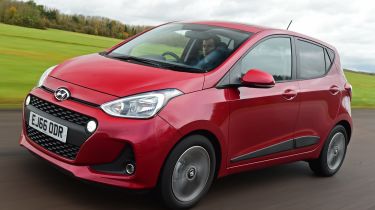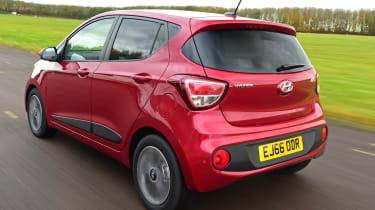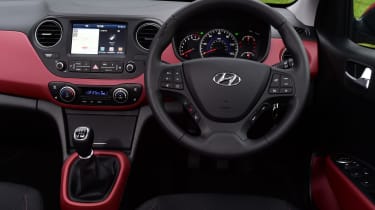New Hyundai i10 facelift 2017 review
Refreshed Hyundai i10 gets a new infotainment system and a fresher look, but is it enough?

The Hyundai i10’s moderate updates do just enough to cement its place as one of the better class offerings. There’s definitely more distinctive or fun city cars on sale, yet few match the i10’s blend of comfort, refinement and practicality for the money. Add in the new infotainment system and strong kit tally of this Premium SE spec, and it justifies the extra outlay.
Not long after Volkswagen facelifted its up! range recently, Hyundai has hit back with mid-life revisions for its rival i10. The Korean carmaker hasn’t messed with the formula for the updated city runabout too much, but given its positioning as one of our class favourites that’s no bad thing.
Exterior changes are subtle: the i10 gains a new front bumper with Hyundai’s latest curved trapezium design, while it’s flanked by a couple of circular LED running lights. New air intakes, alloy wheel designs and a black plastic panel in the rear bumper are the other changes you may or may not notice. It remains a small car that errs towards smart functionality more than outright kerb appeal, however.
The cabin remains entirely familiar, too, with some new colour and trim choices – unless, that is, you opt for the top-spec Premium SE model we have here. It features a new seven-inch touchscreen infotainment system as standard, with sat-nav, DAB, Apple CarPlay and Android Auto technology, and a free seven-year subscription to real-time traffic data. It’s more feature-packed than anything in this class, and is intuitive to operate, although lesser models make do with a more humble smartphone dock. Material quality remains very good for the price, the design is attractive and there’s an impressive amount of passenger and boot space. Top-spec models further surprise with features like a heated steering wheel – few cars offer that at this price point.
More reviews
Car group tests
- Hyundai i10 vs Kia Picanto: 2022 twin test review
- Toyota Aygo X vs Hyundai i10 vs Fiat 500: 2022 group test review
- Hyundai i10 vs Toyota Aygo vs Kia Picanto
In-depth reviews
Road tests
- New Hyundai i10 N Line 2024 review: souped-up city car proves size doesn’t matter
- New Hyundai i10 N Line 2020 review
- New Hyundai i10 2020 review
Used car tests
Hyundai hasn’t felt the need to revise the i10’s engine range, which may disappoint some buyers tempted by the punchy turbo powerplants in some rivals. That means you’ll have the make do with either a 65bhp 1.0-litre, or the 86bhp 1.2-litre four-cylinder engine we have here. While the former is zippy around town and sounds pleasing as the revs build, those venturing out onto motorways frequently will find the extra torque and flexibility the 1.2 offers a fine trade-off for the loss of character. However, it still needs to be worked much harder than the 1.0-litre turbo in a VW up!, for example.
Small changes have been made to the i10’s chassis at least, with new suspension bump stops, and a modified steering rack making it a fraction less vague than the old car’s setup. Comfort is still the priority here, however – it cushions all but the very worst potholes from occupants and refinement levels are generally very good. There’s little in the way of excitement or engagement to be found in the i10’s handling, though, despite the improved steering. Still, most buyers won’t be too fussed about that.
Prices for the facelifted i10 increase slightly across the range, with this Premium SE trim starting from £405 more than before – given the extra equipment we think that’s a reasonable sum, and Hyundai’s usually excellent finance deals are likely to be even more tempting.





